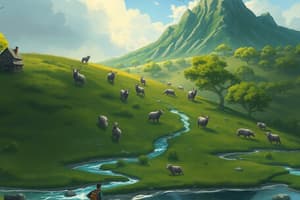Podcast
Questions and Answers
What is the difference between population, community, and ecosystem ecology?
What is the difference between population, community, and ecosystem ecology?
What is exponential population growth?
What is exponential population growth?
The bigger the population, the faster it grows. The size of a population growing exponentially reveals a J shape.
What is logistic population growth?
What is logistic population growth?
When the population grows exponentially at first, but then slows as the population size approaches the carrying capacity.
What factors lead to exponential and logistic population growth?
What factors lead to exponential and logistic population growth?
What is the difference between exponential and logistic population growth?
What is the difference between exponential and logistic population growth?
What are density-independent factors?
What are density-independent factors?
What are density-dependent factors?
What are density-dependent factors?
What is carrying capacity?
What is carrying capacity?
How does the predator/prey interaction lead to oscillations in populations?
How does the predator/prey interaction lead to oscillations in populations?
What are life histories?
What are life histories?
Why is reproduction important in determining an organism's life history?
Why is reproduction important in determining an organism's life history?
What trade-offs exist between growth, reproduction, and survival?
What trade-offs exist between growth, reproduction, and survival?
What is aging?
What is aging?
Why does aging occur?
Why does aging occur?
How does longevity relate to an organism's environment?
How does longevity relate to an organism's environment?
How does natural selection shape longevity?
How does natural selection shape longevity?
What does the term cohort mean?
What does the term cohort mean?
How can birth rate and death rate affect population growth in the Demographic Transition Model?
How can birth rate and death rate affect population growth in the Demographic Transition Model?
How have humans increased the carrying capacity of the Earth?
How have humans increased the carrying capacity of the Earth?
Flashcards are hidden until you start studying
Study Notes
Population, Community, and Ecosystem Ecology
- Population ecology studies groups of individuals of the same species.
- Community ecology examines interactions between different species in a given area.
- Ecosystem ecology integrates both populations and communities with their physical environment.
Exponential Population Growth
- Characterized by unrestricted increase in population size.
- Growth rate accelerates with larger population sizes.
- Represented graphically as a "J curve."
Logistic Population Growth
- Initial exponential growth slows down as resources become limited.
- Population growth stabilizes as it approaches carrying capacity.
- Graphically demonstrated as an "S curve."
Factors Influencing Population Growth
- Exponential growth occurs with no limits on resources or disease.
- Logistic growth factors include limited resources causing growth to stabilize.
Differences in Population Growth Patterns
- Exponential growth remains unbounded while logistic growth is constrained by carrying capacity.
- Represents differing real-world scenarios regarding population dynamics.
Density-Independent vs. Density-Dependent Factors
- Density-independent factors affect populations regardless of size, examples include natural disasters like floods and fires.
- Density-dependent factors depend on population density, examples include competition for resources and disease spread.
Carrying Capacity (K)
- Refers to the maximum sustainable population size in an environment.
- As populations near K, death rates rise, birth rates fall, and emigration increases.
Predator/Prey Interaction
- Oscillations in predator and prey populations result from their dynamic interactions.
- Changes in prey availability impact predator population and vice versa.
Life Histories
- Include vital statistics of a species: age of first reproduction, survival probabilities, reproductive rates, and longevity.
Importance of Reproduction
- Central to species survival and population dynamics.
- Influences life history traits and overall fitness.
Trade-offs in Growth, Reproduction, and Survival
- Organisms face trade-offs due to limited resources, balancing energy between growth, reproduction, and survival.
- Examples include investing more in offspring versus maximizing individual growth.
Aging
- Defined as increased mortality risk as age increases post-maturity.
- Represents a biological phenomenon impacting reproductive rates.
Causes of Aging
- Natural selection's effect diminishes with age; harmful alleles accumulate post-reproduction.
- Aging results from evolutionary pressures and genetic factors.
Longevity and Environmental Hazards
- Longevity correlates with environmental risks; low hazard environments generally lead to longer lifespans.
- Affects age at first reproduction and number of offspring.
Natural Selection and Longevity
- Natural selection influences traits that enhance survival and reproduction, shaping longevity patterns in populations.
Cohorts in Age Structure
- Cohorts are defined as populations divided into age groups to analyze demographic changes.
- Age groups typically span intervals such as 0-4 years, 5-9 years, etc.
Birth and Death Rates in Demographic Transition Model
- Birth and death rates determine population growth speed.
- Understanding rates aids in predicting demographic shifts and devising population policies.
Human Impact on Earth's Carrying Capacity
- Humans have expanded habitats using technology, tools, and agricultural advancements, allowing survival in diverse environments.
- Increased agricultural productivity through improved methods means fewer people can produce more food effectively.
- Advances in public health and infrastructure minimize issues linked to high population densities.
Studying That Suits You
Use AI to generate personalized quizzes and flashcards to suit your learning preferences.





